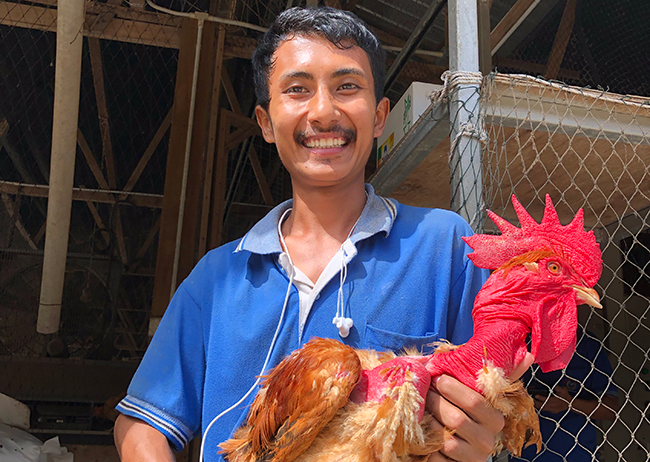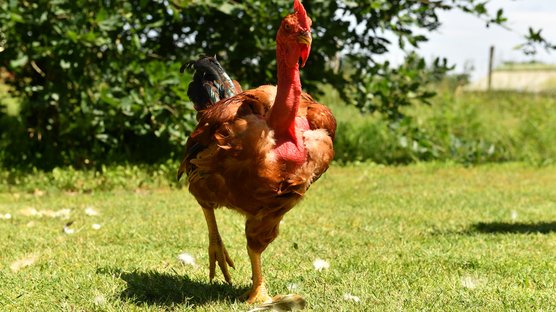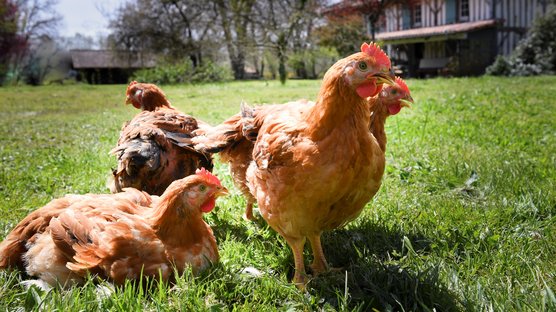
Published on Dec. 16, 2020
Rooster management: Everything you need for a good mix between males and females
The technical-economic results of a flock are generally a reflection of the rearing success of future breeders. Rigor, technicality, observation, and respect of so-called "international" rules are therefore essential to ensure the success of the flock.
Very often, all our efforts and attention are directed towards the female breeders, given the significant number of subjects. However, males are responsible for 50% of the technical-economic result of the flock and must be raised in an equal technical way. It is therefore important not to forget them, and to bring them comfort and technical management.
Challenges of brooding
Remember that a breeder male is subjected to a lot of stress from the first day: hatching, handling, sexing at cloaca and finally vaccination. The females are subjected to the same manipulations, with the exception of sexing which is generally done by color, generating less stress. The male lines are generally more sensitive to the beginning of rearing than the females. Make sure that their environment is ideal for a good start: bacteriological quality and freshness of water, clean feed available, a warm and dry litter, without obstacles to allow the chicks to move and finally a good temperature and comfort zone. Sufficient and easily accessible feeding and watering equipment is essential.
The management of males and females is a bit different, so it is highly recommended to raise roosters and females in different rooms. This way, all technical requirements can be adjusted differently: feeding program and days without feed (no 5/7 for males in rearing, unlike hens), intensity and lighting program. Growth and sexual maturity can thus be better controlled.
The role of the lighting program
For males and females, the brooding period is similar: ensure a very high light intensity on the first day to stimulate the chicks and encourage social interaction, with only one hour of nighttime on the first night. Then gradually decrease the light intensity and the lighting duration according to the adapted lighting programs. For male lines, the lighting program is established more quickly. Do not hesitate to contact your SASSO sales representative to advise you on the most suitable lighting programs according to your location.
Unlike the females, the aim is to raise the males with very low intensity (1.5lux) and with a constant light duration equal to 8 hours over the whole rearing period, with a so-called "flat" program. Females and roosters are very sensitive to light, even at a very low intensity. A very bright moonlight can already be enough to stimulate the birds in bright buildings to eat and drink. The hens and roosters also pick up the surrounding noise very well. Therefore, even at a very low intensity, males can interpret the light period as a daytime period. However, it is possible to increase the intensity of the light during feeding times to encourage consumption.

Differences in light intensity in a barn (First picture: 90lux. Second picture: 30lux. Third picture: 1.5lux. The measurements were made at the height of the chicks).
Impacts of light on testicular growth
The objective is to numb the testicular growth of the roosters with light. In addition, a low intensity of light reduces the nervousness of the males.
It is then possible to wake and obtain mature roosters in a very short time (almost a week) thanks to light stimulation: first increasing the intensity and then the duration of lighting. Stimulation is therefore a function of the maturity of the females: when laying is imminent, the males must be stimulated. Once the roosters are mature, the roosters and hens can then be grouped together.

Evolution of the size and irrigation of the testicles
Bodyweight control and sorting of males
The growth period is also very critical for the skeleton development of the rooster and its reproductive system as well as its good mobility. Nutrition remains an important factor, as the management of the rearing. We recommend carefully following the SASSO roosters’ growth curves, keeping in mind that the ration is always a function of growth. It is important to maintain and control the target weights for indicated male breeders. For this purpose, it is strongly recommended to sort the males from three weeks of age, in order to separate the large from the small, and to make a first sorting of the ones that are not conform. The groups can be fed differently, allowing to progressively slow down the growth of the too heavy individuals, and to progressively accelerate the growth of the lightest ones. This sorting must be done each week in order to obtain a good uniformity of the flock at the time of transfer. 80% uniformity is very easy to obtain if the above instructions are carried out well.
The transfer
When the males are transferred to the production barn, a sorting is necessary. It is useless to transfer roosters that are too small or roosters with a conformation that does not allow optimal mating: humpback or scoliosis, arched, crossed, or twisted legs, drooping wings or low gait. As long as the rearing follow-up and sorting have been done in a rigorous way, there should not be another big sorting at the time of the transfer. Moreover, it is preferable not to mix under-mature males with hens if these ones are already too mature. Whenever possible, we recommend setting up a rooster pen at the back of the production building. Until the males are sufficiently fit for mating, they can be placed in this pen. The aim is to have the hen's first mating just before the first egg.
Finally, the loading of the males is very dependent on the observation of the grower. Our genetic work has improved the fertility of the roosters, making them more active, but also more aggressive. An excess of males can therefore lead to hen mortality, as well as a decrease in fertility and a raise of laying on the ground. We recommend transferring only 5% of the roosters at the time of transfer, and to gradually increase this percentage.
In production
As soon as roosters and hens are mature, the management of the mix is done by observation. However, there are still rules to be followed.
It is important to continue to weigh the roosters regularly to ensure that there is always a constant weight gain. A loss of weight or muscle leads to a regression in the size of the testicles and consequently a decrease in sperm production, testosterone levels and therefore natural mating behavior. Be careful to check the muscular condition of the keel, which should not be too important for males. This last characteristic is less obvious for high yielding male lines, such as our C or X lines.
It is also necessary to ensure that the environment is ideal for the rooster: good ventilation, water and litter management. A humid litter is a risk factor for pododermatitis that can alter the natural mating and health of roosters (like hens).
Rooster feed must be distributed in an equitable manner that respects their nutritional needs to ensure daily weight gain. The feed distribution must be uniform to mix the food ingested, and also to avoid a high heterogeneity of the flock. Keep in mind that poor conditions lead to a decrease in the health of the rooster and consequently a decrease in natural mating.
Observation is necessary for roosters’ recharge. When the egg production begins, it is essential to have a homogeneous distribution of males in the building and among the hens, to make sure that the hens go down on the ground sufficiently during mating periods (40% at light ignition, 60% at the end of the afternoon), and that there are no hen mortalities. From 40 weeks of age, it is possible to refill young roosters (younger, slightly overweight) by sorting out the males to be took out and the roosters that have not been productive (non-reddening of the legs and cloaca, good condition of the tail feathers). This refill makes it possible to overcome a problem that would have occurred at the beginning of production.
It is finally necessary to check the hens’ feathering, which is a vitality character of hens, and the good distribution of the roosters. The shape of the flanks is also a good indicator of vitality and percentage of males.
What you need to remember:
The first weeks of life of the males are crucial. Be sure to raise them with an adapted lighting program (duration, intensity), with sufficient access to feed and water, with a ration adapted to growth while having a good feed balance. All these elements are very important for the formation of the skeleton and the development of the reproductive organs.
Observation and sorting are necessary to obtain a flock of productive and efficient male breeders.
Good management will ensure good flock results!




